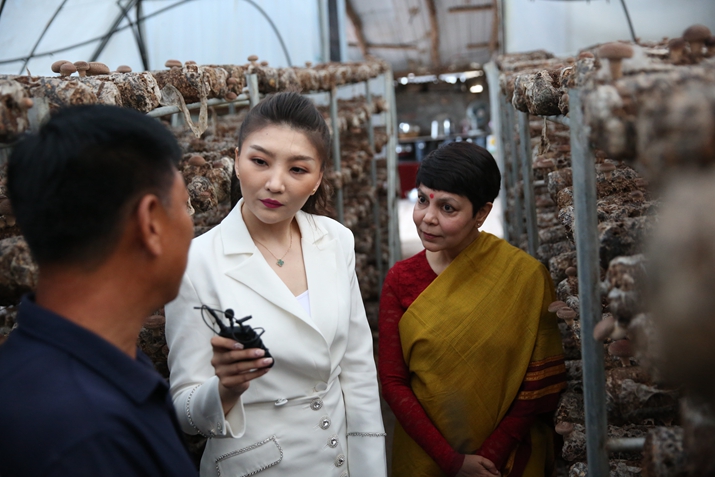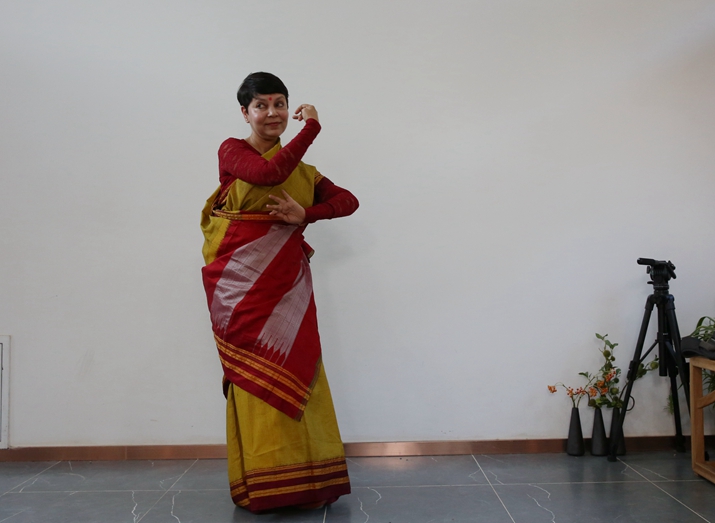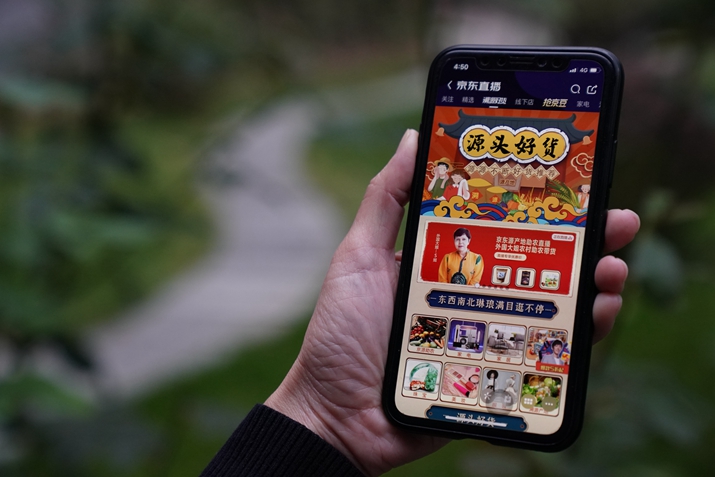How much can a foreigner sell live-streaming 2 hours in a poverty alleviation campaign?
Beijing Review by Sudeshna Sarkar ,November 12, 2020 Adjust font size:
When I got a job in China, my first thought was of the things I would love to do there: visit Tibet Autonomous Region, climb the Great Wall, ride the magic Sky Train which hurtles through air suspended from the rails and three of whose carriage sides are of glass... But never in my wildest dreams did I imagine that I would become an online "star," selling things live!
Yet that is what I found myself doing in September, three months before the deadline for eradication of absolute poverty in China.
To give you an idea of the size of China's e-commerce market, it's been the largest in the world for seven consecutive years, according to a report by China Internet Network Information Center in September. In the first half of this year, this market notched up a stupefying 5.15 trillion yuan ($736.7 billion) in online sales. Buying and selling things online has become a way of life, from cities to remote villages.
This has been made possible due to the drive to build infrastructure, from roads in villages to telecom towers; innovation in technology including digital payments; and the flourishing of online retail platforms like JD.com and Taobao.
During my stay in China, e-commerce embraced a new trend, live-streaming. Sitting in your little stall or a studio in a small village you can show your products to millions of people around the country and even across the borders, answer their queries, and they order goods and pay immediately.
Contributing a brick

JD.com's host Kunbic Noor (right) and Beijing Review's Sudeshna Sarkar live-stream to promote agricultural products in Fuping County, Hebei Province in north China, on September 15 (ZHANG WEI)
Live-streaming especially showed its usefulness during and after the novel coronavirus disease (COVID-19) epidemic, becoming a potent tool to kickstart the economy. One of my favourite memories is of Li Qiang, Deputy Mayor of Wuhan, the city in central China where the first COVID-19 cases were reported, taking part in his first live-streaming on April 8, when Wuhan reopened after a long lockdown.
Li, wearing a mask, talked about his favourite hot and dry noddles, a typical Wuhan delicacy. He urged viewers to buy them and other local products to put the economy back on its feet and on the first day of the campaign, according to media reports, nearly 300,000 items worth 17.9 million yuan ($2.7 million) had been sold.
So when Beijing Review started making a series of videos this year to highlight the factors behind the success of the poverty alleviation campaign, live-streaming was chosen as one of the subjects. However, this time we were not just going to report on the trend but be part of it.
It was the brainwave of Li Nan, our web editor, who had conceived of the series. Her reason was very simple. And touching.
"As a reporter, I have been to many poverty-stricken rural areas and written about their efforts to rise from poverty," she told me. "But I want to do something more hands-on instead of remaining an onlooker. Since live-streaming is an effective way for farmers to reach the market in the aftermath of the epidemic, let’s do one to sell their products."
I was ready to try but nervous too. Suppose no one watched us? Also, since I was to be one of the live-streamers and my Chinese is not good enough, would people be persuaded to buy? Nan seemed to think being a non-Chinese would be my X factor, like not being a woman was live-streamer Li Jiaqi's, who sold 15,000 lipsticks within minutes and earned the title "Lipstick Brother No.1".
Precious partnership

Kunbic Noor (center) and Sudeshna Sarkar (right) listen to a mushroom grower’s COVID-19 experience during their live-streaming on September 15 (SHI GANG)
I learned that while the actual live-streaming may be a matter of minutes, behind it lies years of efforts.
Since people were still cautious about traveling in September, Nan chose neighbouring Hebei Province in north China. The village of Luotuowan in Fuping County was our destination.
It opened my eyes to how live-streaming is connected to history and social initiatives. Zhou Zhansheng, executive deputy chief of the Publicity Department of Fuping, told us Marshal Nie Rongzhen, one of China's founding fathers, built the country's first revolutionary base in the county during the War of Resistance Against Japanese Aggression (1931-45).
In his twilight years, Nie was so distressed by the poverty in Fuping that he once said tearfully he would never get peace even after death until the county was lifted from poverty. President Xi Jinping, who used to work in Hebei in the 1980s, was moved by the story and decided to make that happen.
Fuping was the first poverty-stricken area Xi visited after he was elected general secretary of the Communist Party of China Central Committee in 2012. And Luotuowan was among the first two poor villages he went to. In February this year, Fuping stepped across the poverty line.So Fuping has a special place in China’s history of poverty alleviation.
The county teamed up with JD.com in September 2016 to fight against poverty, in one of the special partnerships between impoverished areas and private enterprises to help in the former's development. Early this year, JD.com's live-streaming arm launched its poverty alleviation platform, the Jingyuan Farmers' Channel, to help rural residents sell their goods online. It had held around 100,000 live-streaming promotions for Chinese farmers. So when Nan approached JD.com with the live-streaming proposal, they agreed since they were keen on creating a greater buzz about the local products.

Our live-streaming promotion from a village studio in Fuping on September 15 (SHI GANG)
Fuping is a major mushroom base. Due to the epidemic, 1,800 tons of mushroom, mostly button mushroom, could not reach the market, hitting the farmers.
When button mushrooms are ready for harvest, they have to be picked immediately or will become flat, and their price will go down. So farmers check them throughout the night and this backbreaking labor was lost during the epidemic.
The grower we visited during the live-streaming told us he was selling his crop at almost half the price. But he was still on the job, uncomplaining and stoic, tending to his plants as he talked to us. For me, that was the image of the Chinese farmers, who bear the economy on their shoulders: never say die and never give up.
JD.com also gave us a host to do the actual work during the live-streaming and the 25-year-old, who is a talk show host with a wellknown TV channel, will remain the face of inclusion for me.
Kunbic Noor is from the Kazakh ethnic group and comes from Urumqi, capital city of Xinjiang Uygur Autonomous Region in northwest China. Beautiful, willowy and with amazing composure, she spoke almost as fast as China’s vaunted high-speed trains, rattling off the prices and specialties of the products we were selling—from dates, to rose tea and cooked chestnuts to a mouth-watering mushroom sauce—without needing to look at the script.
Kunbic has a special affinity for poverty alleviation live-streamings, having started her career in the new trend in April. Her first event was a targeted poverty alleviation campaign for farmers in Inner Mongolia Autonomous Region, north China, where she sold local products like beef jerky, noodles and yogurt.
"I was very nervous and worried that I wouldn't be able to help the local goods sell well," she confessed. "I felt I had a heavy responsibility and didn't sleep all night, staying up to memorize the script. I also tried out each product to get a better understanding of it."
New profession

Asked by a viewer to do an Indian dance, Sudeshna Sarkar obliges during the live-streaming on September 15 (SHI GANG)
The importance of live-streaming and the people who make it happen was officially recognized in July, when China included live-streaming sales personnel among the nine new accepted professions, most of them related to new technologies.
Kunbic said with the online media and the fifth media, or mobile phones, impacting traditional media, as well as the impacts of the epidemic, live-streaming has become the general trend and many anchors are vying to be live-streamers.
When JD.com asked her to host their live-streaming, though worried that it was different from traditional media hosting work, she thought she must be "brave to learn and experience more things in order to grow better and keep learning."
During our live-streaming, she needed to be on her toes constantly and multi-task. She interacted with viewers, answered their queries and announced the winners of the lucky draws that were part of the event to draw more buyers.

A buyer browses the live-streaming page on JD.com (ZHANG WEI)
One of the officials who watched our program at the JD.com studio in Luotuowan was Ma Yingjun. Actually based in Beijing, Ma was deputed to Fuping for two years as part of the Central Government's drive to assist the remaining impoverished areas. He called it a special experience that he will always cherish.
He thinks live-streaming is important because the growth rate of the traditional online market will decline and new growth points are required to sell local products. Live-streaming is direct, transparent, and interactive in real time.
I asked him what brought him to watch us. His answer warmed my heart.
"We are grateful to anyone who comes to help us," he said. "We want as much public exposure as possible for our good products, for the hard work of the people. We want people to know about Fuping."
I am happy to say that over 510,000 people watched the live-streaming and though we sold goods worth only a bit over 5,000 yuan ($756), JD.com's Zhang Kejun told us that she received calls from officials from different areas, wanting to do a similar thing.
"China's road to prosperity was not built in a day," Nan told us. "It was built brick by brick. And this was our brick."
The author is an Indian editorial consultant with Beijing Review